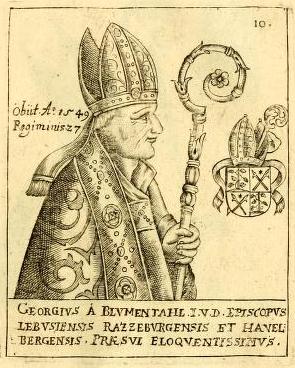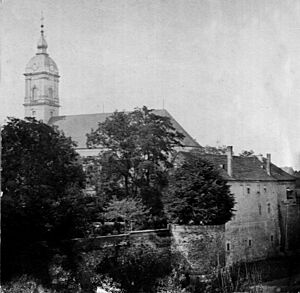Georg von Blumenthal facts for kids
Quick facts for kids Georg von Blumenthal |
|
|---|---|
| Bishop of Lebus | |
 |
|
| Church | Roman Catholic |
| Diocese | Diocese of Lebus |
| In Office | 1524–1550 |
| Predecessor | Dietrich von Bülow |
| Successor | John VIII Horneburg |
| Other posts | Prince-Bishop of Ratzeburg (1525–1550) |
| Personal details | |
| Born | 1490 Horst, modern Heiligengrabe |
| Died | 25 September 1550 Lebus |
| Buried | St. Mary's Cathedral |
Georg von Blumenthal (1490 – 25 September 1550) was an important German leader. He was a Prince-Bishop of Ratzeburg and Bishop of Lebus. This meant he was both a religious leader (a bishop) and a ruler of a territory (a prince). He also worked as a special advisor for the Margraviate of Brandenburg and led the Viadrina University in Frankfurt (Oder).
Contents
Georg von Blumenthal's Early Life
Georg von Blumenthal was born in 1490 in a place called Horst, which is now part of Heiligengrabe. He came from a noble family in Brandenburg called the von Blumenthal. His father, Hans von Blumenthal, owned several villages and manors.
Education and Early Career
Georg started his career early. By 1507, he was working as a secretary for Bishop Dietrich von Bülow. Later, in 1513, he became the head of the cathedral in Lebus. At the same time, he was chosen to be the rector (a top leader) of the Brandenburg University in Frankfurt. He earned a special degree in law, called a "Dr. iur. utr."
In 1520, he became a canon (a type of priest) at Ratzeburg Cathedral. He was also chosen to be the Bishop of Havelberg that same year. However, he could not take this position because the Elector of Brandenburg disagreed.
Becoming a Bishop
In 1524, Georg von Blumenthal became the Bishop of Lebus. Soon after, he also became the Bishop of Ratzeburg. He took over from Heinrich Bergmeier. This appointment was strongly opposed by Duke Magnus I of Lauenburg.
Life as a Bishop
Georg von Blumenthal spent most of his time in the Diocese of Lebus. He had someone else represent him in Ratzeburg. In 1528, he had a dangerous conflict with some nobles in Brandenburg. He barely escaped an attack on his palace in Fürstenwalde.
In 1529, he went to Ratzeburg. There, he had a preacher named Thomas Aderpul arrested. This preacher supported the new religious ideas of the Reformation. This led to a long legal battle in the Imperial Chamber Court. The court finally ruled in favor of Bishop Blumenthal in 1540.
Fighting the Reformation
In 1530, Bishop Blumenthal went with Elector Joachim I to a big meeting called the Diet of Augsburg. At this meeting, he managed to get an order against Duke Magnus I for taking church property. He also won another court case against the Duke in 1536. To pay for these legal battles, the bishop and the Ratzeburg cathedral had to sell valuable church treasures.
Georg von Blumenthal also helped arrange the second marriage of Joachim II, the Elector of Brandenburg. Joachim II married Hedwig of Poland, who was Catholic.
During his lifetime, Georg von Blumenthal was known as a "Pillar of Catholicism." This means he was a strong supporter of the Catholic Church. He used his position at Viadrina University to fight against the Reformation. The Reformation was a big movement that challenged the Catholic Church.
Even his opponents, like Margrave Joachim II, respected him. They admired his strong stand against changes he believed were wrong. He used every legal way he could to oppose these changes. Because of this, Martin Luther, a key figure in the Reformation, said that Blumenthal should be "generally hated."
Attacks and Escape
Not everyone respected him. He was attacked twice in his palaces by groups who supported the Protestant movement. Once, he was attacked at Fürstenwalde by a "robber-baron" named Nickel von Minkwitz. During this attack, Bishop Blumenthal escaped through a window while disguised. His brother, Matthias, stayed behind to defend the palace. He was also attacked at Ratzeburg.
As the Prince-Bishop of Ratzeburg, he was the last Catholic ruler in northern Germany. As Bishop of Lebus, he was the only bishop in Brandenburg to remain Catholic during the Protestant Reformation.
Georg von Blumenthal died in Lebus in 1550. He was buried in St Mary's Cathedral, Fürstenwalde.


